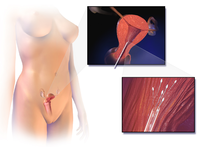
Photo from wikipedia
The objective of this work was to evaluate pregnancy rates in buffaloes subjected to fixed-time AI (FTAI) during the year in Argentina. The data analysed was collected between 2016 to… Click to show full abstract
The objective of this work was to evaluate pregnancy rates in buffaloes subjected to fixed-time AI (FTAI) during the year in Argentina. The data analysed was collected between 2016 to 2019 in a farm located in Paso Florentin City (27°20′33″ latitude and 58°08′27″ longitude) in Corrientes, Argentina. The animals were grazing native pastures (Andropogon lateralis, Paspalum almum). Ten fixed-time AI (FTAI) sessions were performed, 6 within the favourable season (BS, March–June) and 4 in the outbreeding season (OBS; September–December). Murrah and Mediterranean breed (n = 141) buffaloes were used. All animals were healthy, without anatomical alterations and with normal reproductive tracts. Heifers (H), adult females with calf (AFC), and dry buffaloes (DB) were used. The average (± s.d.) weight of the animals were 459.0 ± 37.5 kg, 581.3 ± 53.6 kg, and 583.3 ± 53.1 kg, respectively. The presence of corpus luteum (CL) or a dominant follicle (≥8 mm) at the beginning of the protocol was recorded. BS ovulation induction: Ovsynch (n = 182); Day 0 gonadotrophin-releasing hormone (GnRH; 100 μg, busereline acetate), Day 7 prostaglandin F2α (150 μg, cloprostenol), Day 9 GnRH and FTAI 16 h after the last GnRH injection. For the OBS (n = 85): Day 0 intravaginal device (700 mg of P4) + oestradiol benzoate (0.2 g), Day 8 removal of the device + prostaglandin F2α + oestradiol cypionate (0.1 g) + eCG (400 IU) and Day 10 FTAI (52–56 h) after device removal. Semen from 5 bulls of proven fertility was used, and the same technician performed all the inseminations. A specifically designed format to record the data were used and the average ± s.d. of the physiological and the meteorological parameters were calculated. Pregnancy was detected 40 days after FTAI using ultrasonography. Comparison within variables were performed using ANOVA and Tukey test, with InfoStat-Statistical Software. A total of 267 inseminations were performed, and the overall pregnancy rate (PR) was 37.45% (100/267). Comparing BS with OBS, PR were 40.7% (74/182) and 30.6% (26/85) (P 0.05]. The presence of a CL at the beginning of the FTAI protocol had a positive effect on PR during the year in all categories [31.79% (55/173) H, 40.42 (38/94) AFC, 21.51 (17/79) DB vs. 25.45% (28/110) H, 29.68 (19/64) AFC, 19.56 (9/46) DB; P < 0.05]. Season had a significant effect over PR, but rain, temperature, daylight, and humidity did not differ during the year. These results show the feasibility of FTAI in water buffalo, confirm that it is possible to maintain the PR during the year, and demonstrate successful performance of protocol induction in cyclic females during the year. More research is needed to improve PR in buffaloes in Argentina, to explain the low results in suckled and dry adult buffaloes, and to analyse the effect of meteorological conditions over the breeding performance of the animals.
Journal Title: Reproduction, Fertility and Development
Year Published: 2021
Link to full text (if available)
Share on Social Media: Sign Up to like & get
recommendations!